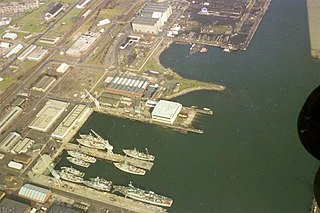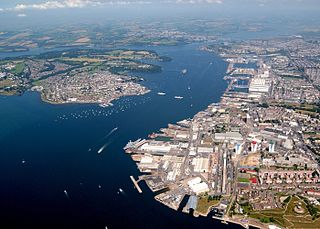
The Commander-in-Chief Fleet (CINCFLEET) was the admiral responsible for the operations of the ships, submarines and aircraft of the British Royal Navy from 1971 until April 2012. The post was subordinate to the First Sea Lord, the professional head of the Naval Service. In its last years, as the Navy shrank, more administrative responsibilities were added.

Rosyth Dockyard is a large naval dockyard on the Firth of Forth at Rosyth, Fife, Scotland, owned by Babcock Marine, which formerly undertook refitting of Royal Navy surface vessels and submarines. Before its privatisation in the 1990s it was formerly the Royal Naval Dockyard Rosyth. Its primary role now is the dismantling of decommissioned nuclear submarines. It is also the integration site for the Royal Navy's newest aircraft carriers, the Queen Elizabeth class as well as the Type 31 Frigate.

The Commander-in-Chief, The Nore, was an operational commander of the Royal Navy. His subordinate units, establishments, and staff were sometimes informally known as the Nore Station or Nore Command. The Nore is a sandbank at the mouth of the Thames Estuary and River Medway. In due course the Commander-in-Chief became responsible for sub-commands at Chatham, London, Sheerness, Harwich and the Humber.
The admiral-superintendent was the Royal Navy officer in command of a larger Naval Dockyard. Portsmouth, Devonport and Chatham all had admiral-superintendents, as did some other dockyards in the United Kingdom and abroad at certain times. The admiral-superintendent usually held the rank of rear-admiral. His deputy was the captain of the dockyard.

His Majesty's Naval Base, Devonport is one of three operating bases in the United Kingdom for the Royal Navy and is the sole nuclear repair and refuelling facility for the Royal Navy. The largest naval base in Western Europe, HMNB Devonport is located in Devonport, in the west of the city of Plymouth, England.

Admiral of the Fleet Sir Houston Stewart, was a Royal Navy officer and briefly a Liberal Party Member of Parliament. After serving as a junior officer in the Napoleonic Wars, Stewart became commanding officer of the third-rate HMS Benbow in the Mediterranean Fleet and took part in the bombardment of Acre during the Egyptian–Ottoman War. He went on to be Captain-Superintendent of Woolwich Dockyard and then Controller-General of the Coastguard.
Admiral Sir Simon Alastair Cassillis Cassels, was a senior Royal Navy officer who served as Second Sea Lord and Chief of Naval Personnel from 1982 to 1986.

The Commander-in-Chief, Plymouth, was a senior commander of the Royal Navy for hundreds of years. Plymouth Command was a name given to the units, establishments, and staff operating under the admiral's command. Between 1845 and 1896, this office was renamed Commander-in-Chief, Devonport. The Commanders-in-Chief were based in what is now Hamoaze House, Devonport, Plymouth, from 1809 to 1934 and then at Admiralty House, Mount Wise, Devonport, from 1934 until 1996.
Admiral Sir Anthony Templer Frederick Griffith Griffin was a Royal Navy officer who went on to be Controller of the Navy (1971–1975) and chairman of British Shipbuilders (1977–1980).
Vice Admiral Sir James Edward Campbell Kennon KCB CBE was a Royal Navy officer who ended his career as Chief of Fleet Support.
Vice Admiral Sir John Morrison Forbes KCB was a British Royal Navy officer who became Naval Secretary.
Admiral Sir (John) Rae McKaig was a Royal Navy officer who became Flag Officer, Plymouth.
Vice Admiral Sir Arthur Mackenzie Power KCB MBE was a Royal Navy officer who became Flag Officer, Plymouth.

Malta Dockyard was an important naval base in the Grand Harbour in Malta in the Mediterranean Sea. The infrastructure which is still in operation is now operated by Palumbo Shipyards.

The Admiral-superintendent, Portsmouth was the Royal Navy officer in command of the Naval Dockyard. Portsmouth from 1832 to 1971; prior to this date a resident Commissioner of the Navy Board had had oversight of the yard, since 1649. In May 1971 command responsibility for naval staff in the dockyard was merged into the wider local command structure, initially under the dual designation of Flag Officer, Portsmouth and Admiral Superintendent, Portsmouth but in July 1971 was again renamed Flag Officer Spithead and Port Admiral Portsmouth after a couple of months. These joint titles was used until 1975, and despite the name change the command still covered the same geographic area and operational responsibilities until 1996 when its ceased to exist as a separate command appointment and its responsibilities were assumed by the staff of Flag Officer First Flotilla.
Naval Home Command administered training and garrison functions for the Royal Navy from 1969 to 2012. Its commander was Commander-in-Chief, Naval Home Command (CINCNAVHOME).

The Flag Officer Portsmouth was created following changes in the naval shore command organisation in the United Kingdom in July 1969. This role merged some of the former duties of Commander-in-Chief, Portsmouth and Admiral-superintendent, Portsmouth into one area commander. First established in May 1971 until July that year when the title was altered to Flag Officer, Spithead. This office was revived again in August 1975 when the former post of Flag Officer Spithead was abolished. The office existed until October 1996 when it too was abolished.

The Port Admiral, Portsmouth was a senior Royal Navy appointment first created in July 1971. In September 1971, all remaining flag officers in the Royal Navy holding the position of admiral superintendent at Royal Dockyards were re-designated as port admirals. This office was held jointly with the office of Flag Officer, Spithead until August 1975 when that post holders title was altered to Flag Officer, Portsmouth.

The Flag Officer Plymouth was a senior Royal Navy appointment first established in July 1969. The office holder was responsible for the administration of the faciliites of the two major Royal Navy at Plymouth and Portsmouth. The appointment continued until 1996 when it was abolished.







